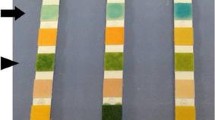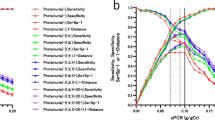Abstract
Although the quantification of protein excretion is valuable for diagnosing and monitoring renal disease, accurate, timed, urine collection entails practical difficulties in children. Several authors have shown that the random urine protein/creatinine ratio (UP/UC) correlates well with timed protein excretion. A novel dipstick, Multistix PRO, has recently enabled us to analyze concentrations of both urinary protein and creatinine, semi-quantitatively, in 60 s. The aim of this study was to investigate whether the UP/UC values obtained by Multistix PRO correlate well with those obtained by quantitative methods and daily urinary protein excretion. In order to obtain the UP/UC values, we measured urinary protein and creatinine concentrations both semi-quantitatively by Multistix PRO and quantitatively by conventional methods. The relationship between the semi-quantitative UP/UC by Multistix PRO and the quantitative UP/UC by conventional methods was analyzed. Similarly, the relationship between the semi-quantitative UP/UC and daily urinary protein excretion was studied. Semi-quantitative UP/UC by Multistix PRO correlated closely with both quantitative UP/UC and daily urinary protein excretion (r=0.86 and r=0.91, respectively). A cut-off level of heavy proteinuria, i.e., nephrotic range of proteinuria (>3.5 g/day) corresponded to 3.0, assessed by UP/UC by Multistix PRO. The semi-quantitative UP/UC by Multistix PRO correlated well with both quantitative UP/UC and daily urinary protein excretion, and use of the Multistix PRO would avoid errors and difficulties associated with timed urine collection. It is, therefore, a useful tool to monitor the urinary protein excretion in children with renal diseases at outpatient clinic.
Similar content being viewed by others
Avoid common mistakes on your manuscript.
Introduction
Proteinuria is an important manifestation of renal disease, and changes in urinary protein excretion are valuable in monitoring the clinical course and predicting the outcome. Additionally, the quantification of protein excretion in children has required accurately timed urine collection. However, this procedure entails practical difficulties in small children, often with incomplete urine sampling and timing errors [1]. Several authors have independently shown that the random urine protein/creatinine ratio (UP/UC) correlates well with timed protein excretion, both in adults and in children [1, 2, 3, 4].
Recently, a novel dipstick, Multistix PRO, which enables us to analyze concentrations of both urinary protein and creatinine semi-quantitatively in only 60 s, has become commercially available [5].
The aim of this study was to investigate whether the values of UP/UC obtained with Multistix PRO correlate well with those obtained by quantitative methods and daily urinary protein excretion.
Subjects and methods
Ninety-two urine samples, including 57 randomly collected and 35 timed samples, were obtained from 36 patients attending our department between February 2003 and June 2004 (mean age 10.1 years, range 0–24.9 years) There were 13 cases of chronic glomerulonephritis, 14 of idiopathic nephrotic syndrome, seven sick neonates, one case of Alport’s syndrome, and one of orthostatic proteinuria.
Thirty-five urine samples by 24 h timed collection were obtained from six patients with idiopathic nephrotic syndrome and three patients with chronic glomerulonephritis. Urine samples were frozen at −20°C until required for analysis.
Urinary protein and creatinine concentrations were measured both semi-quantitatively by dipsticks and quantitatively by conventional method, as follows: for semi-quantitative measurements, Multistix PRO dipsticks (Bayer, Elkhart, Ind., USA) were used according to the manufacturer’s instructions. The strips include a reagent pad for protein, which is based on a color change of tetrabromophenol blue for detection of protein at >15 mg/dl, and a pad for creatinine that uses the peroxidase activity of copper–creatinine complexes at >10 mg/dl. The dipsticks were read on a Clinitek 50 reflectance photometer that gave us semi-quantitative result for both protein and creatinine as follows: urinary protein concentration (in milligrams per deciliter) 0, 15, 30, 100, 300, or 1,000, urinary creatinine concentration (in milligrams per deciliter) 10, 50, 100, 200, or 300. The UP/UC value was calculated from these semi-quantitative data and defined as semi-quantitative UP/UC. As the UP/UC ratio was calculated from these semi-quantitative data, it could vary from 0 (0 mg/300 mg) to 100 (1,000 mg/10 mg). For the quantitative determination of urinary protein and creatinine, the pyrogallol red method and the creatinase method, respectively, were used, and the quantitative UP/UC value was also calculated from these quantitative data.
The relationship between the semi-quantitative UP/UC by Multistix PRO and the UP/UC by quantitative measures was analyzed, using random urine samples. The relationship between the semi-quantitative UP/UC or the urinary protein concentration by Multistix PRO and daily urinary protein excretion was also analyzed, using timed urine samples.
Statistical methods
We used the Spearman rank correlation test to calculate the relationships among the semi-quantitative UP/UC by Multistix PRO, urinary protein concentration by Multistix PRO, quantitative UP/UC and daily urinary protein excretion. P values less than 0.05 were considered to be significant.
Results
The semi-quantitative UP/UC by Multistix PRO correlated well with that by quantitative measures in the random urine samples, as shown in the upper graph in Fig. 1 (r=0.86, P<0.01).
Relationships between semi-quantitative UP/UC by Multistix PRO and quantitative UP/UC or daily urinary protein excretion. Upper graph relationship between UP/UC by Multistix PRO and quantitative UP/UC using random urine samples. Lower graph relationship between UP/UC by Multistix PRO and daily urinary protein excretion
Similarly, the lower graph in Fig. 1 reveals that the semi-quantitative UP/UC by Multistix PRO correlated well with daily urinary protein excretion in timed urine samples (r=0.91, P<0.01).
A cut-off level of heavy proteinuria, i.e., the nephrotic range of proteinuria (>3.5 g/day [6]) corresponded to 3.0, assessed by semi-quantitative UP/UC, because urine samples showing UP/UC of 2.0 and 3.0 demonstrated mean daily urinary protein excretion of 2.22 (range 1.5–2.5) and 8.04 (range 2.7–19), respectively.
In contrast to the good correlation between UP/UC by Multistix PRO and daily urinary protein excretion (r=0.91), the semi-quantitative urinary protein concentration by Multistix PRO showed less impressive correlation with daily urinary protein excretion in timed urine samples (r=0.85).
Discussion
Proteinuria is quantified for diagnostic and prognostic purposes and to assess responses to therapy. Quantification of proteinuria has traditionally demanded timed urine collection. This poses logistical problems, especially in young children who have yet to achieve continence at night. Timing and volume errors, and the need to correct the protein excretion rate for body surface area, make this method inaccurate and cumbersome [1].
Using a turbidimetric method, Shaw et al. found a close correlation between random urine UP/UC and 24 h protein excretion in adults [3]. Elises et al. and Houser confirmed these observations in children [1, 4].
The Multistix PRO is a new urine dipstick that allows rapid measurement of UP/UC [5]. Results obtained with the Multistix PRO (UP/UC value) coincided well with those obtained from daily urinary protein excretion in timed urine samples (r=0.91) and the UP/UC by the quantitative method (r=0.86), while the semi-quantitative urinary protein concentration obtained by Multistix PRO shows less impressive correlation with daily urinary protein excretion (r=0.85). This is consistent with the result reported by Kaiser et al., who demonstrated that the simple measurement of semi-quantitative urinary protein concentration by dipstick has low specificity (56%) to detect abnormal proteinuria [7].
In conclusion, a novel dipstick, Multistix PRO, can give us semi-quantitative UP/UC values in 60 s, which correlates well with both quantitative UP/UC and daily urinary protein excretion in children. It is, therefore, worthwhile to monitor urinary protein excretion, in children with renal diseases, at the outpatient clinic because of the quickness and simplicity of Multistix PRO.
References
Elises JS, Griffiths PD, Hocking MD, Taylor CM, White RH (1988) Simplified quantification of urinary protein excretion in children. Clin Nephrol 30:225–229
Ginsberg JM, Chang BS, Matarese RA, Garella S (1983) Use of single voided urine samples to estimate quantitative proteinuria. N Engl J Med 309:1543–1546
Shaw AB, Risdon P, Lewis-Jackson JD (1983) Protein creatinine index and Albustix in assessment of proteinuria. BMJ 287:929–932
Houser M (1984) Assessment of proteinuria using random urine samples. J Pediatr 104:845–848
Pugia MJ (2001) Albuminuria and proteinuria in hospitalized patients as measured by quantitative and dipstick methods. J Clin Lab Anal 15:295–300
Vogt BA, Avner ED (2003) Nephrotic syndrome. In: Behrman RE, Kliegman RM, Jensen HB (eds) Nelson textbook of pediatrics, 17th edn. Saunders, Philadelphia, pp 1753–1757
Kaiser C, Bergel F, Doehring-Schwerdtfeger E, Feldmeier H, Ehrich JH (1992) Urine test strips: reliability of semi-quantitative findings under tropical conditions. Pediatr Nephrol 6:145–148
Author information
Authors and Affiliations
Corresponding author
Rights and permissions
About this article
Cite this article
Kaneko, K., Someya, T., Nishizaki, N. et al. Simplified quantification of urinary protein excretion using a novel dipstick in children. Pediatr Nephrol 20, 834–836 (2005). https://doi.org/10.1007/s00467-004-1808-2
Received:
Revised:
Accepted:
Published:
Issue Date:
DOI: https://doi.org/10.1007/s00467-004-1808-2





